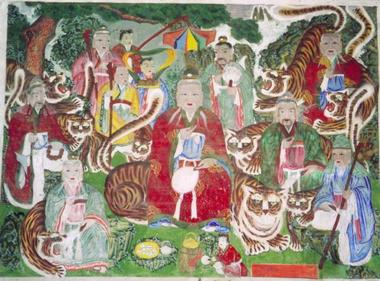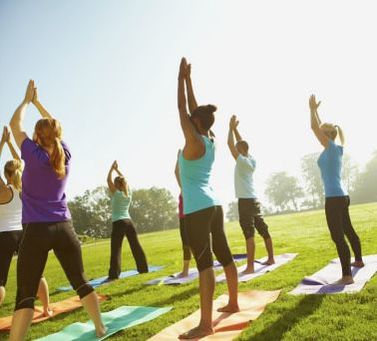The Taoist Art of Longevity:
How to Practice SunDo Breathing in Yoga postures & meditation
|
Nearly every culture and religion has its myths of immortality; few, however, have an actual discipline dedicated to the idea. This is very much the case with the Taoist breathwork practice of SunDo — or what we might think of as “the art of longevity.”
By harnessing a powerful life-giving force called “Qi”,’ the Taoist SunDo Masters unlocked one of nature’s greatest secrets to lifelong vitality. You may be familiar with the recent practice of Yin Yoga — a gentle yogic discipline that emphasizes long-held poses for release of tension and greater mental and physical calm. Yin Yoga came to prominence in the 1980s as a useful balance to the more physically rigorous "yang" yoga styles of the day. |
In truth, most Yin Yoga styles are descendants of Taoist Yoga, a complete breath and posture system that is both physically challenging and highly restorative in nature. SunDo, one of the oldest Taoist practices in this tradition, calls for the holding of postures with quiet stillness, similar to Yin Yoga, but with a deeply mindful focus on restorative breathwork unmatched in its healing benefits.
|
Qi and breath are the secret to SunDo’s remarkable power, but there’s really nothing secretive about it. You see, Qi isn’t some unknowable magic; it’s the simple ability draw in, circulate, and expel breath — a process we share in harmony with all living things around us. This special mastery of breath and poses rooted in the wisdom of Taoist teachings, afforded its practitioners unparalleled health and longevity, yet SunDo still remains a mystery to many — even knowledgeable scholars of Taoism and meditation. Why? For that answer we need to set our sights on the verdant mountains of the Korean Peninsula. |
The SunDo mystique — San Shin, Shinseon, and SunDo Taoist Masters
Mountains have always inspired an eye-widening sense of wonder in us. They represent a stairway to the divine on earth — a holiness and natural sanctuary that has captivated human beings since our earliest ancestors shared the world with these monumental marvels. Mountains are also that rare refuge where we can deeply explore the mind, body, and soul — free of the common distractions that so often lead us away from our personal growth and well-being.
Mountains have always inspired an eye-widening sense of wonder in us. They represent a stairway to the divine on earth — a holiness and natural sanctuary that has captivated human beings since our earliest ancestors shared the world with these monumental marvels. Mountains are also that rare refuge where we can deeply explore the mind, body, and soul — free of the common distractions that so often lead us away from our personal growth and well-being.
This view is deeply embedded in the spiritual identity of Koreans, and the San-Shin, or Korean mountain deities, are reflective of this cultural tradition. The San Shin are benevolent spirits associated with the mountain peaks of the Korean countryside and are ubiquitous in Korean art, culture, and folklore.
The Korean people have an instinctive respect and admiration for the power and artistry of nature. This is seen in the popular depictions of the San-Shin, and the related Shinseon, or “Eight Immortals” in both Chinese and Korean spirituality. The Shinseon were legendary figures who achieved immortality through communion with nature and mastery of the Taoist arts, like SunDo. The immortals are believed to bring health, enlightenment, prosperity, and longevity to humankind.
|
One might think of the elite Sundo Masters, like the internationally renowned Hyunmoon Kim, as people who have embraced the power of nature and enlightenment, allowing them to reach a higher state of being. And in these sacred mountains, the Taoist SunDo Masters spent most of their lives, mitigating distractions, honing Qi meditation, preserving the art, and living in oneness with nature.
This is also why SunDo has remained shrouded in mystery since the 1100s as an exclusive mountain hermit practice. It wasn’t until the late 1960’s that one of the masters, Be-Kyung, brought the practice down from the mountains and opened the first SunDo school for the public in Seoul, Korea. |
Looking for the next frontier in restorative yoga for your studio? You just found it.
We’ve embraced yoga and meditation practices for decades in the West, and as the popularity of these disciplines has grown, so has the demand for a greater number of softer, more restorative yoga styles with noted long-term benefits to mind-body health and longevity.
SunDo practice has now spread across Asia, Europe, and the Americas, quickly gaining popularity with individuals looking for a breathwork practice that lets them live longer, happier, and healthier lives.
Integrating a variety of restorative elements into one holistic practice, SunDo offers instructors and studios an unparalleled tool for cultivating better health and sustained well-being in their students — and your clients will love it!
|
How to Meditate the Taoist Yoga Way
SunDo’s true x-factor comes in its unification of poses with breathwork. In breaking from the completely still posture of lotus-style meditation, as well as the strict posture focus of popular Yin Yoga, SunDo brings together Taoist breathing technique and postures with longer holds to allow practitioners to experience a meditative state of ever-deepening relaxation. SunDo recognizes that our stresses are not only physical strains, but also mental, emotional, and unconscious in nature — people need a yoga practice that purifies and de-clutters the body and mind. |
After six months-to-one year of consistent SunDo breathing practice, most students report a noticeable reduction in their mental and physical stress, better energy levels, as well as a greater ability to calmly work through the challenges they face in their lives. In fact, most practitioners of SunDo achieve optimal wellness despite initial health concerns.
Stress is a part of human nature — it’s a survival mechanism, but there is nothing natural about living under the constant stress of the modern world. Periods of prolonged physical and mental strain are frequently linked to health risks like heart disease, high blood pressure, diabetes, obesity, and even Alzheimer’s — all of which contributed to premature aging and failing health.
SunDo naturally resets your body’s ability to manage stress and gives you the power to live the long, active, and enjoyable life you dream of. This is the Taoist art of living longer and living better.
Stress is a part of human nature — it’s a survival mechanism, but there is nothing natural about living under the constant stress of the modern world. Periods of prolonged physical and mental strain are frequently linked to health risks like heart disease, high blood pressure, diabetes, obesity, and even Alzheimer’s — all of which contributed to premature aging and failing health.
SunDo naturally resets your body’s ability to manage stress and gives you the power to live the long, active, and enjoyable life you dream of. This is the Taoist art of living longer and living better.




